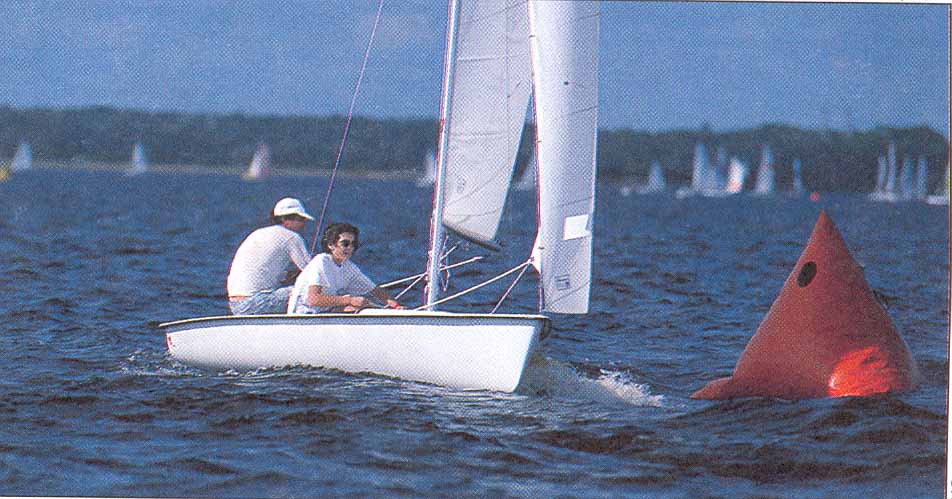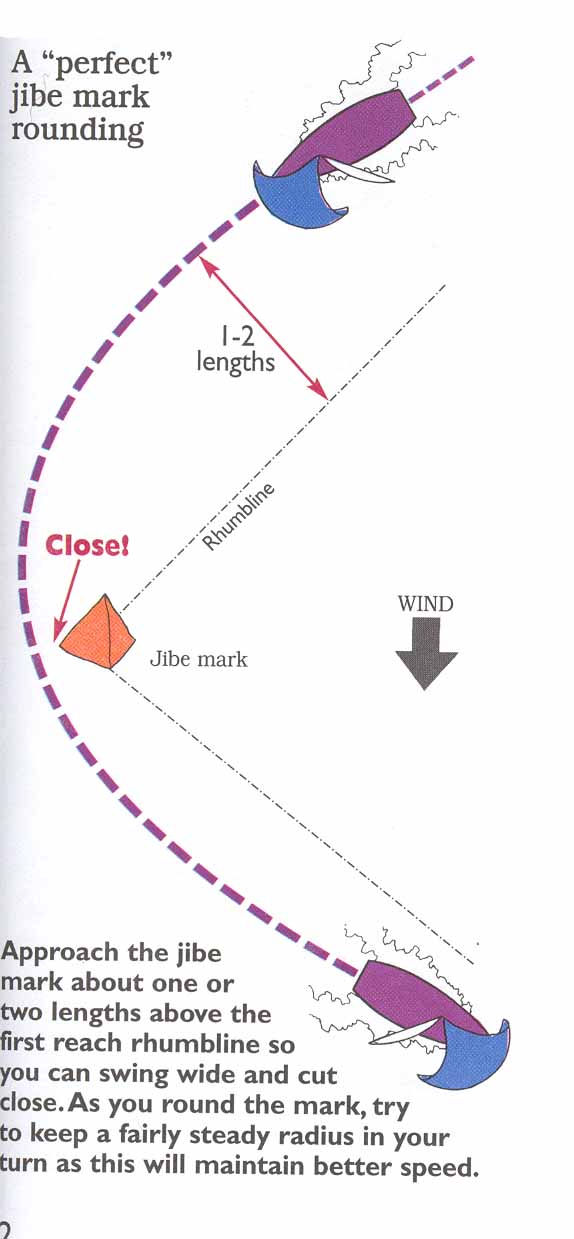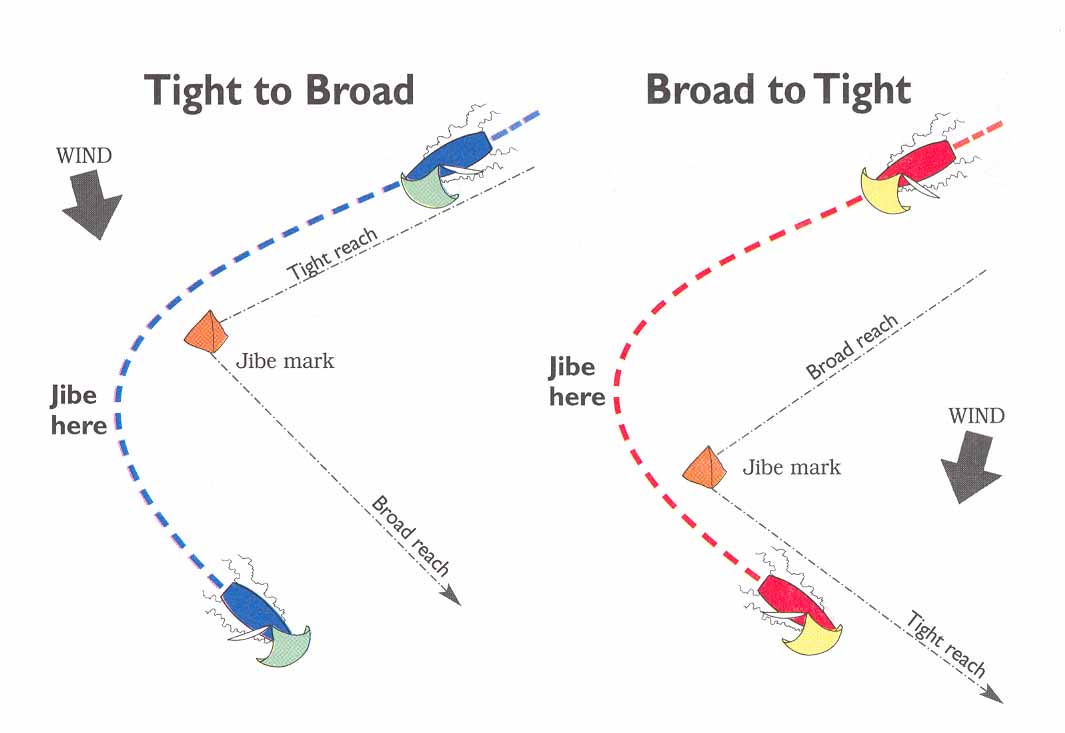
Execute a “Perfect” Rounding
By David Dellenbaugh
 |
| If you want to have consistently good roundings at the jibe mark, you must first be able to execute a smooth, fast turn without any other boats around. During your next practice session, find a mark and work on jibing around it. Use your weight and sails to turn the boat as much as possible, and experiment to see what kind of turn will get you around the mark fastest. |
Whenever you approach a jibe mark, your strategic challenge is figuring out how to make the fastest, smartest rounding in the existing conditions, assuming there are no other boats around. Once you know this, you can use tactical moves to implement this strategy in the middle of a fleet.
Getting around a jibe mark without wasting time or distance requires many
different skills and teamwork. You must be able to turn your boat smoothly,
handle the sails efficiently, and choose an optimal course to round the mark.
Here are some practical suggestions for how you can execute a better strategic
rounding at the jibe mark.
Look and plan ahead
The key to sound strategizing at any point on the race course is making an
effort to look ahead and develop a gameplan. For example, you should never start
a race without studying the first beat and trying to figure out which side is
favored. The same is true when you approach the jibe mark. Here are some
questions to consider while you are sailing on the first reach:
 |
If you keep your chute but it looks like the reach will be tight, pull your
jib or genoa over to the starboard side of the boat (the new leeward side)
before the rounding. This way if the reach turns out to be too tight for the
spinnaker, you’ll be ready to hoist a headsail without delay.
• Do you have to jibe?
Just because you’re “supposed to” jibe around the mark doesn’t mean
you have to. If the wind has shifted left, maybe it’s a better move to stay on
starboard jibe for a while. A good guildeline is that if you can fetch the
leeward mark on port tack, you should jibe; if not, think about the possibility
of not jibing.
• Will you go high or low?
Consider the present wind velocity, wind direction, current and waves
and what has been happening to each for the last half hour or so. Then make a
strategic plan for the second reach. Do this before you reach the jibe mark so
you can come out of the traffic jam headed in the right direction.
Maintain your speed
Whenever you turn your boat there is the potential for lost speed, and this is
true at any jibe mark. While there may be tactical situations when you want to
slow down at the mark, strategically you always want to sail as fast as
possible.
One of the biggest culprits in lost speed is the drag caused by excess rudder movement. To prevent this, use your crew weight and sail trim aggressively to steer with minimal rudder deflection.
When you do use your rudder, try to keep it at a fairly steady angle so the
boat turns at a constant radius. This is faster than changing the rudder angle a
lot.
Cut the mark close
When you want to get somewhere quickly (as in a race), don’t sail extra
distance. Sailing farther usually takes more time, so always look for shortcuts.
One place where you can often gain an advantage is at mark roundings.
My rule of thumb is that you should always round a mark close enough that you can reach out and touch it. OK, this can be difficult at the windward mark where you have to deal with anchorline scope and boom length. But it works at the jibe mark. If you can’t touch the mark when you pass its lee side, you are sailing extra distance and it will take you longer to finish.
It may not ever be possible to make a “perfect” rounding (though perhaps every rounding is perfect in its own way), but if you try the things here you will move closer to perfection, and that is fast. Then you will just have to deal with other boats who are trying to make their own perfect roundings.
| When the wind has shifted left so the first reach is tight and the second reach is broad, the best strategy is to jibe after rounding the mark. It would be slow to sail high on the tight first reach, so keep up your speed by aiming straight for the jibe mark. Just after you pass the mark, begin bearing off into a jibe. The idea is to use your speed from the first reach to help you make ground to leeward on the second reach. By delaying your jibe until after the mark, you will end up below the second reach rhumbline, and this will give you a better angle (with more speed) for that leg. Of course, this assumes you don’t have other boats cutting inside you at the mark. |
 |
| When the wind has shifted right so the first reach is broad and the second reach is tight, the best strategy is to jibe before rounding the mark. It would be slow to sail low on the broad first reach, so sail faster by aiming a little high of the jibe mark. When you are roughly upwind of the mark, begin bearing off into a jibe. The idea is to have enough space so you can complete your jibe (i.e. get your pole in place on the new windward side) before your bow gets to the mark. This makes the jibe much easier, allows you to “close the door” on boats behind and, most importantly, lets you start the tight second reach as high as possible (since low would be slow). |
 |
| These handicap boats are doing “dip-pole” jibes at a light-air reach
mark. While USA 50840 is doing a nice job keeping her chute full through the
jibe, it looks like she is making a pretty wide rounding and has completed
her jibe at least a boatlength to leeward of the mark. Unless the second
reach is really a run, 50840 has sailed extra distance during this rounding
and that will cost her precious time. To prevent this at the next jibe mark, the helmsperson should either begin the jibe sooner or approach the mark wider on the near side, or both. Their goal should be to round within a few feet of the mark. |
Dave publishes the newsletter Speed & Smarts. For a subscription call: 800-356-2200 or go to www.speedandsmarts.com